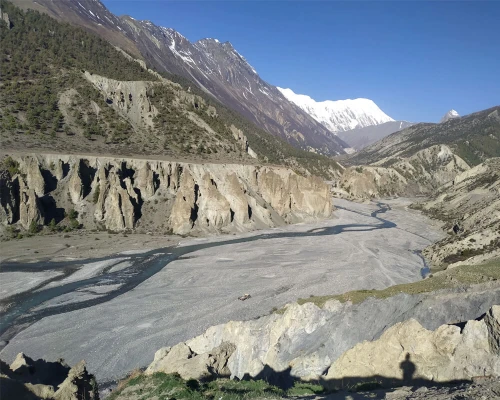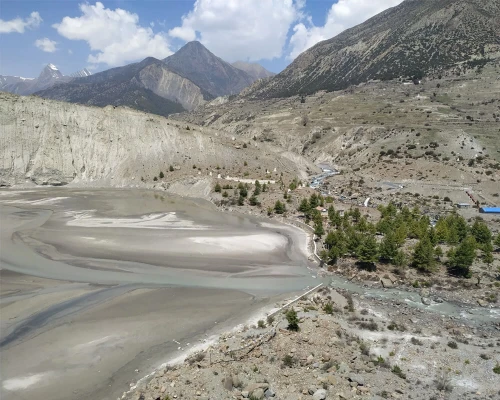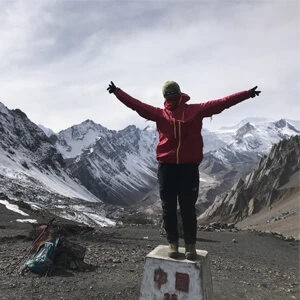Annapurna Circuit Trek with Tilicho Lake
Adventure may hurt you but monotony will kill you. Are you in need of some inspiration in your life? If so, the Annapurna Circuit Tilicho Lake Trek doesmore than answer the question. Lying deep into the colossal spine of the mighty Himalayas, situated at over 4,919 meters Lake Tilicho is one of the highest lakes in the world formed by the glacial melt of the northern slopes of the Annapurna Massif and Thorong Peak. The Lake is a blessed place, sacred for both Hindus and Buddhists. A journey to its turquoise shores is both an uplifting and challenging one that inspires just about everyone who manages it. The lake comes to its own as the morning sun rises glistening supreme providing yet another gem to reflect on when making this epic journey to circumvent the Annapurna Massif. With the all-embracing peaks of Mount Manaslu, Himalchuli, Lamjung Himal, Annapurna II, Annapurna III, Annapurna IV, Gangapurna, and Tilicho Peak dominating the scene, it’s a journey very rarely forgotten.

The trek to Tilicho is becoming a popular side hike on the Annapurna Circuit Trek. The hike takes an additional 3 - 4 days; no camping is required as new lodges have been built between Manang and the lake. The final approach to Tilicho Lake is a day hike from the lodge at Tilicho Base Camp.
On The Trail:

Long before reaching Tilicho Lake 4,919 meters / 16,138 feet, there is so much on the trail to tease the senses, a journey of snow-capped peaks, mist-shrouded valleys, isolated communities, and remote monasteries. Trails that lead us into knotted lush forests, stunning waterfalls, along turbulent rivers, and through well-kept weathered mountain villages. We hike up through the Marsyangdi Valley set within a powerful Buddhist culture inhabited by hardy, ever-welcoming people. If that were not enough the dramatic mountain views on the way can often defy descriptive superlatives. The side trek to Tilicho Lake puts a thicker layer of icing on a very unique journey.
Please note: Weather conditions on the upper stages of the route (particularly the section from Manang to Tilicho Lake and the crossing of the Thorong La Pass 5416m) can vary considerably, from very pleasant to sometimes extreme. This will often depend on the time of year you choose to trek but not always. Please do not hesitate to contact us for advice if needed.
The best times to complete the Annapurna Circuit with Tilicho Lake Trek are Autumn (September to November) and Spring (March to May).
Similarly, you may also quickly check our less explored, newly opened, and hidden valleyNar Phu Trek, Khopra Ridge Trek, Classic Annapurna Base Camp Trek, and more stunning packages.
Annapurna Circuit with Tilicho Lake Treking Difficulty
The Tilicho High-Altitude Trek is moderately challenging as you will have to navigate through demanding terrain and high altitudes. During the journey, you will pass through steep ascents, rocky trails, and narrow paths, especially, the most challenging section is the trail leading to Tilicho Lake. Also, taking you to nearly 5,000 meters, the lack of oxygen at such altitudes can cause altitude sickness. Additionally, the trails can be slippery and treacherous, particularly during the pre-monsoon and post-monsoon seasons when snow or rain may affect the path conditions. Moving on, another factor adding to the trek's difficulty is the remoteness of the region. The trek also demands long hours of walking, often on rugged and uneven trails, which can be physically taxing.
Best Time To Visit Tilicho Lake
The best time to visit Tilicho Lake is during the pre-monsoon (Spring) and post-monsoon (Autumn) seasons, specifically from March to May and September to November.
These months offer stable weather, clear skies, and optimal trail conditions, making the trek more enjoyable and safer. In Spring, the trails come alive with blooming rhododendrons and lush greenery, creating a vibrant and colorful trekking experience. The weather is generally mild, with daytime temperatures comfortable for hiking and nights not excessively cold, even at higher altitudes.
Autumn, on the other hand, is renowned for its crystal-clear skies and panoramic mountain views. The post-monsoon season ensures that the air is free from dust and haze, offering unobstructed vistas of the Annapurna and Nilgiri ranges. Temperatures are moderate, and the trails are dry, reducing the risks associated with slippery paths. Visiting outside these windows, such as during the Monsoon or Winter, poses challenges like heavy rains, potential landslides, and snow-covered trails.
Tilicho Pass Trekking Permits and Cost:
When trekking with Nepal Trekking Experts, the permit fees are included in your package. Your experienced guide will obtain all required permits on your behalf with your passport. To enter the Annapurna region, you will require two permits, which can both be obtained in Kathmandu or Pokhara before commencing your trek.
- The TIMS (Trekkers Information Management System) Card costs 2000 Nepali rupees, and as per the latest rule, it will be obtained through the trekking agencies only.
- The Annapurna Conservation Area Permit (ACAP), which costs 3000 Nepali rupees, is available through the Nepal Tourism Board, Bhirkutimandap Kathmandu, or Pokhara.
Booking And Payment With Nepal Trekking Experts
To book your trek with us, you have to send a deposit of 10% of the total cost of the trek. Please also forward a copy of your passport, a passport-sized photo, and full flight details if and when available. For your convenience, you may also forward the deposit to us online through our website. It is completely safe, and as soon as you make it, you will get an automatic receipt in your inbox. The rest of the payment can be paid upon arrival.
If you have any questions, do not hesitate to contact us anytime. We are always ready to assist.


-(1).webp)









 based on 18 reviews
based on 18 reviews





